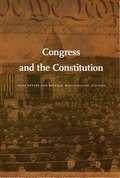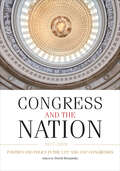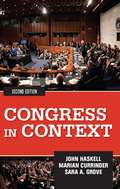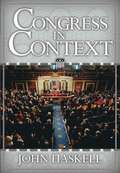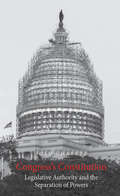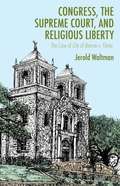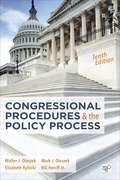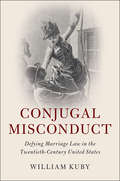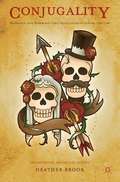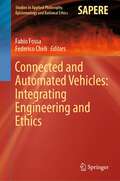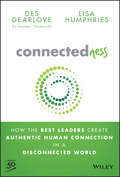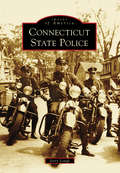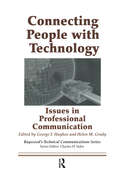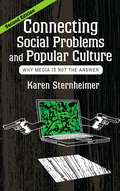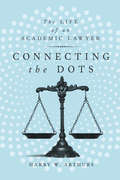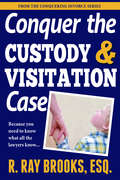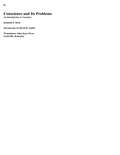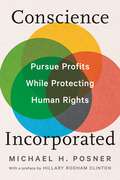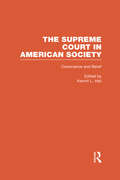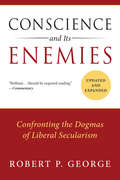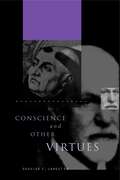- Table View
- List View
Congress and the Constitution
by Keith E. Whittington Neal DevinsFor more than a decade, the U. S. Supreme Court has turned a skeptical eye toward Congress. Distrustful of Congress's capacity to respect constitutional boundaries, the Court has recently overturned federal legislation at a historically unprecedented rate. This intensified judicial scrutiny highlights the need for increased attention to how Congress approaches constitutional issues. In this important collection, leading scholars in law and political science examine the role of Congress in constitutional interpretation, demonstrating how to better integrate the legislative branch into understandings of constitutional practice. Several contributors offer wide-ranging accounts of the workings of Congress. They look at lawmakers' attitudes toward Congress's role as a constitutional interpreter, the offices within Congress that help lawmakers learn about constitutional issues, Congress's willingness to use its confirmation power to shape constitutional decisions by both the executive and the courts, and the frequency with which congressional committees take constitutional questions into account. Other contributors address congressional deliberation, paying particular attention to whether Congress's constitutional interpretations are sound. Still others examine how Congress and the courts should respond to one another's decisions, suggesting how the courts should evaluate Congress's work and considering how lawmakers respond to Court decisions that strike down federal legislation. While some essayists are inclined to evaluate Congress's constitutional interpretation positively, others argue that it could be improved and suggest institutional and procedural reforms toward that end. Whatever their conclusions, all of the essays underscore the pervasive and crucial role that Congress plays in shaping the meaning of the Constitution. Contributors. David P. Currie, Neal Devins, William N. Eskridge Jr. . John Ferejohn, Louis Fisher, Elizabeth Garrett, Michael J. Gerhardt, Michael J. Klarman, Bruce G. Peabody, J. Mitchell Pickerill, Barbara Sinclair, Mark Tushnet, Adrian Vermeule, Keith E. Whittington, John C. Yoo
Congress and the Nation 2017-2020, Volume XV: Politics and Policy in the 115th and 116th Congresses
by David HosanskyChronicling the polarized partisan environment during the President Donald Trump’s term, Congress and the Nation 2017-2020, Vol. XV will be the most authoritative reference on congressional lawmaking and trends during the 115th and 116th Congresses. Congress and the Nation is a unique reference product, rivaled only by the annual editions of the CQ Almanac in its coverage of the legislative and policymaking activities of the U.S. national legislature. After its original publication in the mid-1960s in a one-volume work covering 20 years (1945-1965) of lawmaking, the succeeding editions (vols. II – XIII) have been focused on 4 years of lawmaking activity under succeeding presidential administrations. Each new quadrennial edition is organized into 14 policy-centered chapters (economy, homeland security [since vol. XI], foreign policy, defense policy, energy and environment, health, etc.) and two chapters that cover matters internal to Congress and the presidential administration. The policy chapters cover the major legislative activities in the two numbered congresses convened during the four year period. The result is a narrative and analytical account of the lawmaking by the U.S. Congress that provides students, scholars and journalists with a digestible and accurate retrospective accounts difficult to find or reconstruct from news media, as well as longer term historical perspective of congressional lawmaking. This is a landmark series for CQ Press that has proven its value among librarians for decades
Congress and the Nation 2017-2020, Volume XV: Politics and Policy in the 115th and 116th Congresses
by David HosanskyChronicling the polarized partisan environment during the President Donald Trump’s term, Congress and the Nation 2017-2020, Vol. XV will be the most authoritative reference on congressional lawmaking and trends during the 115th and 116th Congresses. Congress and the Nation is a unique reference product, rivaled only by the annual editions of the CQ Almanac in its coverage of the legislative and policymaking activities of the U.S. national legislature. After its original publication in the mid-1960s in a one-volume work covering 20 years (1945-1965) of lawmaking, the succeeding editions (vols. II – XIII) have been focused on 4 years of lawmaking activity under succeeding presidential administrations. Each new quadrennial edition is organized into 14 policy-centered chapters (economy, homeland security [since vol. XI], foreign policy, defense policy, energy and environment, health, etc.) and two chapters that cover matters internal to Congress and the presidential administration. The policy chapters cover the major legislative activities in the two numbered congresses convened during the four year period. The result is a narrative and analytical account of the lawmaking by the U.S. Congress that provides students, scholars and journalists with a digestible and accurate retrospective accounts difficult to find or reconstruct from news media, as well as longer term historical perspective of congressional lawmaking. This is a landmark series for CQ Press that has proven its value among librarians for decades
Congress and the Politics of Problem Solving
by E. Scott Adler John D. WilkersonHow do issues end up on the agenda? Why do lawmakers routinely invest in program oversight and broad policy development? What considerations drive legislative policy change? For many, Congress is an institution consumed by partisan bickering and gridlock. Yet the institution's long history of addressing significant societal problems – even in recent years – seems to contradict this view. Congress and the Politics of Problem Solving argues that the willingness of many voters to hold elected officials accountable for societal conditions is central to appreciating why Congress responds to problems despite the many reasons mustered for why it cannot. The authors show that, across decades of policy making, problem-solving motivations explain why bipartisanship is a common pattern of congressional behavior and offer the best explanation for legislative issue attention and policy change.
Congress in Context
by John Haskell Marian Currinder Sara A. GroveThe U. S. Congress is by the far the least popular--and most misunderstood--branch of the federal government. Congress in Context de-mystifies the institution, giving students a comprehensive and practical understanding of Congress and the legislative process. This book takes a different approach to the study of Congress than other texts. Usually Congress is treated in isolation from the rest of the government. But the Framers of the Constitution explicitly intended for the branches of government to be interdependent. Congress in Context introduces readers to Congress’s critical role in the context of this interdependent system. Using the metaphor of a board of directors, the authors explain the three key roles of Congress within the federal government--authorizing what government does, funding its activities, and supervising how it carries out the laws Congress passes--and shows students how Congress interacts with the rest of the government to exercise these powers. The thoroughly expanded and revised second edition features brand-new chapters on Congress and the courts and Congress and interest groups. It also includes expanded coverage of Congress’s relationship with the executive branch, campaign finance, and today’s major budget issues. Grounded in the latest political science literature coupled with contemporary examples, Congress in Context offers students an informed yet accessible introduction to how the legislative branch carries out its duties.
Congress in Context
by John HaskellA concise and engaging introduction to the workings of Congress, from directing government actions through legislation and oversight to interacting with the executive branch in a separated system of government.
Congress's Constitution: Legislative Authority and the Separation of Powers
by Josh ChafetzA leading scholar of Congress and the Constitution analyzes Congress’s surprisingly potent set of tools in the system of checks and balances. Congress is widely supposed to be the least effective branch of the federal government. But as Josh Chafetz shows in this boldly original analysis, Congress in fact has numerous powerful tools at its disposal in its conflicts with the other branches. These tools include the power of the purse, the contempt power, freedom of speech and debate, and more. Drawing extensively on the historical development of Anglo-American legislatures from the seventeenth century to the present, Chafetz concludes that these tools are all means by which Congress and its members battle for public support. When Congress uses them to engage successfully with the public, it increases its power vis-à-vis the other branches; when it does not, it loses power. This groundbreaking take on the separation of powers will be of interest to both legal scholars and political scientists.
Congress, the Supreme Court, and Religious Liberty
by Jerold WaltmanIn the case City of Boerne v. Flores, the Supreme Court struck down the Religious Freedom Restoration Act of 1993. Waltman offers the first book-length analysis of the act to show how this case contributes to an intense legal debate still ongoing today: Can and should the Supreme Court be the exclusive interpreter of the Constitution?
Congressional Procedures and the Policy Process (Tenth Edition)
by Walter J. Oleszek Mark J. Oleszek Elizabeth Rybicki Bill HeniffThis book reveals how the majority and minority parties use procedural devices to achieve their political goals and offers an assessment of the role of conference committees in reconciling bicameral differences. Not shying away from the complexity of the topic, Oleszek and new co-authors Mark Oleszek, Elizabeth Rybicki, and William Heniff ensure that the machinations of Congress are understandable through an array of interesting examples, topical cases, and anecdotes that they are well-positioned to witness and experience first-hand.
Conjugal Misconduct: Defying Marriage Law in the Twentieth-Century United States (Cambridge Historical Studies in American Law and Society)
by William KubyConjugal Misconduct reveals the hidden history of controversial and legally contested marital arrangements in twentieth-century America. William Kuby examines the experiences of couples in unconventional unions and the legal and cultural backlash generated by a wide array of 'alternative' marriages. These include marriages established through personal advertisements and matchmaking bureaus, marriages that defied state eugenic regulations, hasty marriages between divorced persons, provisional and temporary unions referred to as 'trial marriages', racial intermarriages, and a host of other unions that challenged sexual and marital norms. In illuminating the tensions between those who set marriage policies and those who defied them, Kuby offers a fresh account of marriage's contested history, arguing that although marital nonconformists composed only a small minority of the population, their atypical arrangements nonetheless shifted popular understandings of marriage and consistently refashioned the legal parameters of the institution.
Conjugal Union: What Marriage Is and Why It Matters
by Patrick Lee Robert P. GeorgeThis book defends the conjugal view of marriage. Patrick Lee and Robert P. George argue that marriage is a distinctive type of community: the union of a man and a woman who have committed to sharing their lives on every level of their beings (bodily, emotionally, and spiritually) in the kind of union that would be fulfilled by conceiving and rearing children together. The comprehensive nature of this union, and its intrinsic orientation to procreation as its natural fulfillment, distinguishes marriage from other types of community and provides the basis for the norms of marital exclusivity and permanence. Lee and George detail how the basic moral norms regarding sexual acts follow from the ethical requirement to respect the good of marriage and explain how the law should treat marriage, given its conjugal nature, examining both the same-sex-marriage issue and civil divorce.
Conjugality: Marriage and Marriage-like Relationships before the Law
by Heather BrookConjugal Rites explores the legal shape of marriage as it has been determined by countless decisions concerning entry and exit into the ancient rite. Heather Brook examines the countless rules and protocols governing marriage that make it valid in the eyes of the law. She argues that the various sexual performatives associated with marriage can establish, reinforce, or rupture conjugal unity while exploring the historical and politcal regulations and prohibitions marriage has faced. Brook unites past and present, public and private, to investigate the changing meanings and effects of conjugality, and challenge the way we think about sex, gender and relationships.
Connected and Automated Vehicles: Integrating Engineering and Ethics (Studies in Applied Philosophy, Epistemology and Rational Ethics #67)
by Federico Cheli Fabio FossaThis book reports on theoretical and practical analyses of the ethical challenges connected to driving automation. It also aims at discussing issues that have arisen from the European Commission 2020 report “Ethics of Connected and Automated Vehicles. Recommendations on Road Safety, Privacy, Fairness, Explainability and Responsibility”. Gathering contributions by philosophers, social scientists, mechanical engineers, and UI designers, the book discusses key ethical concerns relating to responsibility and personal autonomy, privacy, safety, and cybersecurity, as well as explainability and human-machine interaction. On the one hand, it examines these issues from a theoretical, normative point of view. On the other hand, it proposes practical strategies to face the most urgent ethical problems, showing how the integration of ethics and technology can be achieved through design practices. All in all, this book fosters a multidisciplinary approach where philosophy, ethics, and engineering are integrated, rather than just juxtaposed. It is meant to inform and inspire an audience of philosophers of technology, ethicists, engineers, developers, manufacturers, and regulators, among other interested readers.
Connectedness: How the Best Leaders Create Authentic Human Connection in a Disconnected World
by Des Dearlove Lisa HumphriesImprove talent retention and employee productivity by encouraging connectedness in your firm In Connectedness, British business journalist and management theorist Des Dearlove delivers an insightful and practical discussion of how firms can build meaningful and authentic connections with their employees, encouraging productivity, improving talent retention, and creating an enduring competitive advantage. You’ll find out why the latest peer-reviewed research lends support to the notion that it is the nature of interpersonal environments – and not compensation – that many employees consider to be the most impactful when they’re deciding whether to exit a job. In the book, you’ll: Explore the most important factors that determine the connectedness of a healthy working environment Common mistakes and myths about employee wellbeing that sidetrack managerial efforts to improve working culture at a firm Examples and case studies that demonstrate the real-world impact of the ideas discussed in the book Perfect for managers, executives, directors, and other business leaders seeking to improve employee retention, productivity, engagement, and health, Connectedness is also a must-read resource for employees, human resources professionals, consultants, and everyone else with an interest in employee wellbeing and workplace productivity and safety.
Connecticut State Police (Images of America)
by Jerry Longohe Connecticut State Police Department was created in 1903 to preserve the peace, arrest convicting offenders, and stay alert to liquor and gambling violations, especially those on Sundays. The birth of the department came at time when temperance leagues began forming across the country. Connecticut State Police is an account of a department and its rise to battle, among other things, "demon rum." Today, troopers cover approximately half of the towns in the state of Connecticut and all of its highways. The CSP became successful and developed a reputation among the law enforcement community as one of the best in the nation. Connecticut state police grew in their responsibilities and expectations, taking on the duties of fire marshal, motor vehicle testing, and dozens of other important and influential agency tasks. This collection of photographs covers the many people, events, and tragedies that have shaped this respected department.
Connecting International Law with Public Law: The Public Law of Gender
by Kim Rubenstein Rubenstein, Kim and Young, Katharine G. Katharine G. YoungWith the worldwide sweep of gender-neutral, gender-equal or gender-sensitive public laws in international treaties, national constitutions and statutes, it is timely to document the raft of legal reform and to critically analyse its effectiveness. In demarcating the academic study of the public law of gender, this book brings together leading lawyers, political scientists, historians and philosophers to examine law's structuring of politics, governing and gender in a new global frame. Of interest to constitutional and statutory designers, advocates, adjudicators and scholars, the contributions explore how concepts such as equality, accountability, representation, participation and rights, depend on, challenge or enlist gendered roles and/or categories. These enquiries suggest that the new public law of gender must confront the lapses in enforcement, sincerity and coverage that are common in both national and international law and governance, and critically and pluralistically recast the public/private distinction in family, community, religion, customary and market domains.
Connecting People with Technology: Issues in Professional Communication (Baywood's Technical Communications)
by George F. HayhoeThis book explores five important areas where technology affects society, and suggests ways in which human communication can facilitate the use of that technology.Usability has become a foundational discipline in technical and professional communication that grows out of our rhetorical roots, which emphasize purpose and audience. As our appreciation of audience has grown beyond engineers and scientists to lay users of technology, our appreciation of the diversity of those audiences in terms of age, geography, and other factors has similarly expanded.We are also coming to grips with what Thomas Friedman calls the 'flat world,' a paradigm that influences how we communicate with members of other cultures and speakers of other languages. And because most of the flatteners are either technologies themselves or technology-driven, technical and professional communicators need to leverage these technologies to serve global audiences.Similarly, we are inundated with information about world crises involving health and safety issues. These crises are driven by the effects of terrorism, the aging population, HIV/AIDS, and both human-made and natural disasters. These issues are becoming more visible because they are literally matters of life and death. Furthermore, they are of special concern to audiences that technical and professional communicators have little experience targeting - the shapers of public policy, seniors, adolescents, and those affected by disaster.Biotechnology is another area that has provided new roles for technical and professional communicators. We are only beginning to understand how to communicate the science accurately without either deceiving or panicking our audience. We need to develop a more sophisticated understanding of how communication can shape reactions to biotechnology developments. Confronting this complex network of issues, we're challenged to fashion both our message and the audience's perceptions ethically.Finally, today's corporate environment is being shaped by technology and the global nature of business. Technical and professional communicators can play a role in capturing and managing knowledge, in using technology effectively in the virtual workplace, and in understanding how language shapes organizational culture.
Connecting Social Problems and Popular Culture
by Karen SternheimerIs violence on the streets caused by violence in video games? Does cyber-bullying lead to an increase in suicide rates? Are teens promiscuous because of Teen Mom? As Karen Sternheimer clearly demonstrates, popular culture is an easy scapegoat for many of society’s problems, but it is almost always the wrong answer. Now in its second edition, Connecting Social Problems and Popular Culture goes beyond the news-grabbing headlines claiming that popular culture is public enemy number one to consider what really causes the social problems we are most concerned about. The sobering fact is that a "media made them do it" explanation fails to illuminate the roots of social problems like poverty, violence, and environmental degradation. Sternheimer’s analysis deftly illustrates how welfare "reform," a two-tiered health care system, and other difficult systemic issues have far more to do with our contemporary social problems than Grand Theft Auto or Facebook. The fully-revised new edition features recent moral panics--think sexting and cyberbullying--and an entirely new chapter exploring social media. Expanded discussion of how we understand society’s problems as social constructions without disregarding empirical evidence, as well as the cultural and structural issues underlying those ills, allows students to stretch their sociological imaginations.
Connecting the Dots: The Life of an Academic Lawyer
by Harry W. ArthursHarry W. Arthurs is a name held in high esteem by labour lawyers and academics throughout the world. Although many are familiar with Arthurs's contributions and accomplishments, few are acquainted with the man himself, or how he came to be one of the most influential figures in Canadian law and legal education. In Connecting the Dots Arthurs recounts his adventures in academe and the people, principles, ideas, motivations, and circumstances that have shaped his thinking and his career. The memoir offers intimate recollections and observations, beginning with the celebrated ancestors who influenced Arthurs's upbringing and education. It then sweeps through his career as an architect of important reforms in legal education and explores his research as a trailblazing commentator on the legal profession. Arthurs analyzes his experiences as a legal theorist and historian and his pivotal role as a discordant voice in debates over constitutional and administrative law. Along the way, he muses on the intellectual projects he embraced or set in motion, the institutional reforms he advocated, the public policies he recommended, and how they fared long term. Framed with commentary on the historical context that shaped each decade of his career and punctuated by moments of personal reflection, Connecting the Dots is a humorous, frank, and fearless account of the rise and fall of Canadian labour law from the man who was at the centre of it all.
Conquering the Custody and Visitation Case
by Ray BrooksYou can help yourself and help your attorney by knowing the best way to prepare and the best way to present the evidence in your Custody And Visitation case. Every judge has a list of things that they must evaluate before they can make a decision in the custody case. If you know what those things are and how you should present them you have the advantage. Preparation is everything, and you will be the one who is prepared if you read these pages and follow these tips. Everything from how to put together a "parenting plan" to how to act and things to say to a "custody evaluator" are included.
Conscience And Its Problem: An Introduction To Casuistry (Library Of Theological Ethics)
by Kenneth E. KirkThis book, originally published in 1927, has proven to be one of the most important and influential books in the field of ethics in the twentieth century. It remains a pertinent, original, and insightful work--a landmark statement of modern casuistry. The Library of Theological Ethics series focuses on what it means to think theologically and ethically. It presents a selection of important and otherwise unavailable texts in easily accessible form. Volumes in this series will enable sustained dialogue with predecessors though reflection on classic works in the field.
Conscience Incorporated: Pursue Profits While Protecting Human Rights
by Michael H. PosnerA guide for business leaders working to create socially conscious, sustainable companies—while pursuing profitsAmid growing international concerns about income inequality, labor abuses, racial injustice, and disinformation online, Conscience Incorporated examines the gaps in current corporate social responsibility measures and what more needs be done to address these challenges. The rise of new technologies such as smartphones and social media have made it easier than ever to document and spread awareness of corporate actions. Despite these developments, large corporations often fail to meaningfully address the human rights abuses linked to their business models and practices. In Conscience Incorporated, Michael Posner addresses what lies at the root of these challenges, drawing on his extensive personal experience as a human rights lawyer, State Department official under President Obama, chair of the Fair Labor Association and Director of the Center for Business and Human Rights at NYU Stern School of Business.Drawing from research into the history of business ethics and anchoring his argument with examples of companies publicly accused of human rights abuses—Nike, Coca-Cola, Walmart, Meta, and more—Posner provides a blueprint for global business leaders to navigate human rights challenges and adopt sustainable corporate practices. Conscience Incorporated highlights the need for increased protections for outsourced workers in faraway nations, greater attention to harmful online content, and prioritization of human rights by investors. He argues that growing public awareness has not been enough to enforce ethical practices for global businesses. As a result, governments, especially in Europe, are becoming more involved in regulating global business practices in various industries.Posner proposes a series of concrete reforms and argues compellingly for why businesses need to devote greater time and resources to protecting basic human rights. Conscience Incorporated is a powerful challenge to the status quo and advocates for a fundamental shift in the principles that govern global businesses.
Conscience and Belief: The Supreme Court in American Society (The\supreme Court In American Society Ser. #Vol. 8)
by Kermit L. HallAvailable as a single volume or as part of the 10 volume set Supreme Court in American Society
Conscience and Its Enemies: Confronting the Dogmas of Liberal Secularism
by Robert P. George"Many in elite circles yield to the temptation to believe that anyone who disagrees with them is a bigot or a religious fundamentalist. Reason and science, they confidently believe, are on their side. With this book, I aim to expose the emptiness of that belief." From the introduction: Assaults on religious liberty and traditional morality are growing fiercer. Here, at last, is the counterattack. Showcasing the talents that have made him one of America's most acclaimed and influential thinkers, Robert P. George explodes the myth that the secular elite represents the voice of reason. In fact, George shows, it is on the elite side of the cultural divide where the prevailing views frequently are nothing but articles of faith. Conscience and Its Enemies reveals the bankruptcy of these too often smugly held orthodoxies while presenting powerfully reasoned arguments for classical virtues.
Conscience and Other Virtues: From Bonaventure to MacIntyre (G - Reference, Information and Interdisciplinary Subjects)
by Douglas C. LangstonConscience, once a core concept for ethics, has mostly disappeared from modern moral theory. In this book Douglas Langston traces its intellectual history to account for its neglect while arguing for its still vital importance, if correctly understood.In medieval times, Langston shows in Part I, the notions of "conscientia" and "synderesis" from which our contemporary concept of conscience derives were closely connected to Greek ideas about the virtues and practical reason, although in Christianized form. As modified by Luther, Butler, and Kant, however, conscience later came to be regarded as a faculty like will and intellect, and when faculty psychology fell into disrepute, so did the role of conscience in moral philosophy.A view of mature conscience that sees it as relational, with cognitive, emotional, and conative dimensions, can survive the criticisms of conscience as faculty. In Part II, through discussions of Freud, Ryle, and other modern thinkers, Langston proceeds to reconstruct conscience as a viable philosophical concept.Finally, in Part III, this better grounded concept is connected with the modern revival of virtue ethics, and Langston shows how crucial conscience is to a theory of virtue because it is fundamental to the training of any morally good person.
